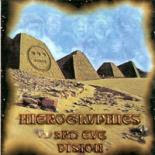Daft Punk's Bastard Demon Child
 Apart from artists such as Chemical Brothers and Fatboy Slim, electronic music has never really excited me that much. There's techno, which is too repetitive. "Club" music, which, being an anti-Top 40 skater punk, has taught me to loathe (what is "club" music, anyway? Basically just progressive house with a bigger sound). Drum & Bass: too noisy. I can't listen to trance because I don't take ecstasy. So besides a few key artists, I opted to spend most of my high school years digesting hip-hop and punk rock music instead.
Apart from artists such as Chemical Brothers and Fatboy Slim, electronic music has never really excited me that much. There's techno, which is too repetitive. "Club" music, which, being an anti-Top 40 skater punk, has taught me to loathe (what is "club" music, anyway? Basically just progressive house with a bigger sound). Drum & Bass: too noisy. I can't listen to trance because I don't take ecstasy. So besides a few key artists, I opted to spend most of my high school years digesting hip-hop and punk rock music instead.
Enter 2001. Daft Punk released one of the most refreshing dance records in years. Songs like "One More Time" and "Harder Better Faster Stronger" swept dance clubs around the world like a storm. Two camera-shy, notoriously reclusive French DJ's single handedly resurrected the fun, care-free era of disco music. Usually similar-sounding artists are immediately signed by record companies looking to profit from a new music fad, but there were few artists available that could match the intensity and creativity that Daft Punk possessed. Ground-breaking music is never created overnight. Daft Punk spent over 4 years meticulously crafting their opus and if copy-cat artists were to follow it wasn't going to happen for some time. I was in love with this record and desired more and the Basement Jaxx's and Crystal Method's didn't quite match up to my expectations.
Enter 2007. Bored at work, I was sent a message from a friend telling me about a show he was attending by a new group named Justice that he was really digging. He sent me a YouTube link of their video, "D.A.N.C.E.". It immediately brought back memories of Daft Punk's melodic, sample-based dance music. I searched for more of their music and was thoroughly impressed enough to stop by the record shop after work and purchase their album. On the way home from the store I popped the CD into my car stereo and was not at all prepared for what I heard coming out of my speakers. Dark. Gothic. Gritty. Organic. Loud. Fucking mind-blowing. I was hooked on it like cocaine.
This album (entitled by a symbol, but commonly called Cross) is an instant dance classic. Constructed by two French DJ's in a basement over the course of 5 years, it's an amazing concept album with equal parts Michael Jackson and Nine Inch Nails. Clearly influenced by Daft Punk (also managed by the same guy who managed Daft Punk, Busy P) they are a force to be reckoned with in the club scene and they breath new life into (or more accurately described, vampirically siphon life from) the stale Electronica genre and create a completely novel and a boatload more exciting sound.
Genesis
Phantom
D.A.N.C.E.



